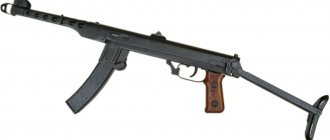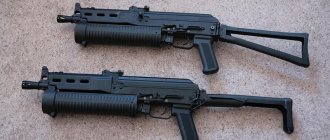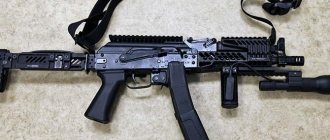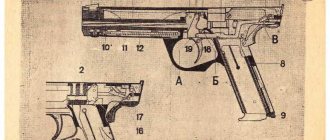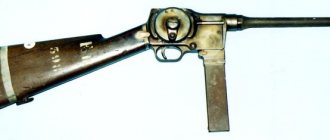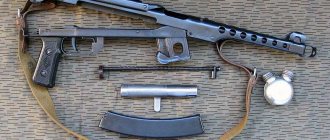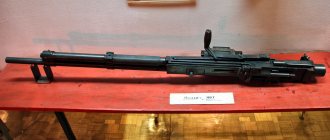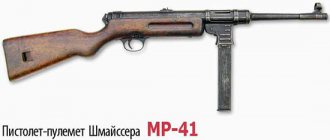PPS-42 and PPS-43 Sudaev submachine gun cartridge caliber 7.62 mm
Difference between PPS-42 and PPS-43
PPS-42 and PPS-43 Sudaev submachine gun caliber 7.62 mm are variants of the submachine gun developed by Soviet designer Alexei Sudaev in 1942. Used by Soviet troops during the Great Patriotic War. The PPS is often considered the best submachine gun of World War II.
Review
Polish PPS-43 SH appeared on the Russian market at the beginning of 2018. This sample was produced in 1949, this is the earliest year that we could pick up in the store. There were variations from 1949 to 1953. This PP was purchased at the Neva Target .
The guys tried their best and, at my request, found the earliest PP for the year, for which I am very grateful to them. It was possible to purchase PPS-43 in the native caliber 7.62x25Blank, or in caliber 10x31 (more expensive). I chose 7.62x25.
When purchasing PPS-43, the following cartridges were purchased at the same time. I still haven't found out who the manufacturer is.
The cartridges turned out to be more expensive than 10x31 and weaker, which made itself felt during the first shooting. Briefly pressing the trigger and releasing it, the PPS-43 continued to shoot as if the trigger was pressed until the cartridges in the magazine ran out. Apparently, due to weak pressure, the bolt does not retract until it engages with the sear and does not have time to lock. Having fired about 150 rounds, uncontrolled shooting was repeated 2 or 3 times, but in shorter bursts (5-6 shots were fired uncontrollably, then the bolt was locked in the rear position).
PPS-42 and PPS-43 - shooting video
Design
PPS is a submachine gun of a design typical for this class of weapon. Automation works by rolling back the massive bolt under the influence of recoil when fired. The barrel is locked with a free bolt under the action of a return spring, compressed when the bolt rolls back. Shooting is carried out from the rear sear. The fire mode is automatic only, there is no single fire mode. The recoil spring is mounted on a guide rod, which is inserted into the hole on the back side of the bolt at the top left. The shutter handle is located on the right.
In accordance with wartime, it was executed rather crudely and generally unaesthetic. It consists of a barrel, a stamped steel receiver connected to the barrel casing by riveting and welding, a fire control handle and a butt. The lower part of the casing, 20-13 mm wide, is open to its entire length.
To improve the accuracy of fire, a muzzle brake-compensator is located in the muzzle of the barrel on the casing. The sighting device consists of a front sight and a sight with a reversible rear sight. The rear sight has two fixed positions - 100 and 200 m, designated by the numbers 10 and 20. Firing in the “20” position is possible up to 300 m.
The safety is located in front of the trigger guard. When it is moved back, it blocks the trigger rod and raises a bar with cutouts that block the cocking handle, rigidly connected to the bolt, both in the lowered and cocked positions. The fuse is moved to the front - combat - position with the index finger. In some modifications, if it is necessary to lock the cocked bolt, the cocking handle can be inserted into an additional transverse groove on the receiver. In this position, the cocked bolt cannot break spontaneously even if the weapon is dropped or receives a strong blow.
Due to the long stroke of the moving parts, the PPS has a reduced rate of fire compared to the PPSh. You can even fire single shots by smoothly pressing and quickly releasing the trigger.
The PPS-42/43 is powered from a box-shaped (sector) magazine with a capacity of 35 rounds, inserted into the receiver (neck), which is equipped with a latch with a safety bracket that prevents accidental removal of the magazine. The magazine has a two-row exit, which increases trouble-free operation and simplifies filling the magazine. The PPSh magazine has a single row of cartridges; In addition, the PPSh magazine has a guide holder in the upper part, which is necessary for installation in the slot for drum magazines.
The stock is metal, folding, and folds onto the receiver. During incomplete disassembly, the trigger box tilts down relative to the receiver, rotating on a fastening axis in front of the magazine neck.
In the PPS-43 model, the return spring is attached to the guide rod using a special stop. The rod is elongated, shifted to the left and passes through a milled groove in the lower left part of the shutter, while its front end also began to serve as a reflector, which ceased to be a separate part. The weight of the bolt was reduced from 570 g to 550 g, the barrel length was reduced from 272 mm to 251 mm, and the butt length was reduced from 245 mm to 230 mm. In addition, the cocking handle has been improved, the safety box, the shoulder rest latch, the barrel casing and the receiver have been combined into one part.
The butt mount has been changed. The butt latch head is located above the receiver in the rear part. The improved pistol grip provides fairly comfortable control of the weapon when shooting with both the butt folded and folded.
The butt mount has been changed. The butt latch head is located above the receiver in the rear part. The improved pistol grip provides fairly comfortable control of the weapon when shooting with both the butt folded and folded.
The weight of the PPS-43 with full ammunition (six loaded magazines) is 6.72 kg, which is less than the weight of the Suomi submachine gun with one 100-round magazine. A bullet fired from a PPS retains its lethal force at a distance of up to 800 m. Firing in short bursts (2-5 shots) is most effective; when firing in long bursts, dispersion increases.
The most significant feature of PPS is its simplicity of design and manufacturability. It is almost entirely assembled from stamped parts connected by welding and rivets. The consumption of materials per unit of PPS-43 was half as much, and labor costs were three times less than for a unit of PPSh-41.
To defeat a single enemy fighter (a tall target) when firing in short bursts from a weapon brought to normal combat, 1 cartridge was needed at a distance of up to 100 m, 2 - at a distance of 150 m, 3 - at a distance of 200-250 m, and 4 cartridge at a distance of 300 m.
Development and production
The PPS submachine gun was developed by the Soviet gunsmith designer Alexei Ivanovich Sudaev in 1942 and was produced at the Sestroretsk arms factory to supply the troops of the Leningrad Front. During the design of this weapon, the famous PPSh-41 was in service with the Red Army, which proved to be effective in combat and technologically advanced in production. But the PPSh had not only advantages, but also disadvantages, such as large dimensions and weight, which significantly complicated the use of this weapon in narrow trenches and cramped spaces in urban battles, as well as by reconnaissance personnel, paratroopers and crews of combat vehicles. In addition, in wartime conditions it was necessary to reduce the costs of mass production of submachine guns.
PPS-43 with folded stock
The PPS submachine gun was designed based on a compilation of the project of A. I. Sudaev and the project of Lieutenant Technician I. K. Bezruchko-Vysotsky (design of the bolt and return system). While food for Leningraders was coming to the besieged city along the road of life, not only refugees, but also new weapons were being taken back from the city.
The first submachine guns passed field tests on June 6-13, 1942 in parts of the Leningrad Front, after which their mass production began at the Sestroretsk Arms Plant. At the end of 1942, the submachine gun was put into service under the name PPS-42.
The following year, 1943, an improved design called PPS-43 was adopted (the barrel and butt were shortened, the cocking handle, the safety box and the shoulder rest latch were changed, the barrel casing and receiver were combined into one part). In total, 46,572 units were produced before the blockade was broken in January 1944. PPS of both modifications.
PPS-43 with the butt unfolded
Sudaev submachine gun mod. 1943 was produced in the USSR from 1943 to 1945. In total, about 500 thousand units of PPS of both modifications were produced.
After the end of the war, in the early 1950s, the PPS was removed from service with the Soviet Army and gradually replaced by the Kalashnikov assault rifle (although it should be noted that the last Soviet manual on PPS was issued in 1955), it remained in service with rear and auxiliary units for a little longer , units of internal troops and railway troops. The PPS was in service with individual paramilitary security units at least until the end of the 1980s. According to information from the Alatyr Museum of Local Lore. (Alatyr is the homeland of Sudaev) The PPS is still in service with the guards of the detention center located near the city.
PPS-42 with folded stock
Options and modifications
USSR - teaching staff model 1942; PPS model 1943
Finland - after analyzing the design of Soviet models, in 1944 the Tikkakoski plant, under the designation m/44, began production of a 9-mm modification of the PPS-43 (chambered 9x19 mm Luger), using Suomi magazines. In total, about 10.4 thousand units were produced. such submachine guns. In 1957-1958, the m/44 was in service with Finnish UN peacekeepers in the Sinai Peninsula.
Germany - a version of the Finnish m/44 was produced under license in small batches in West Germany and Spain under the designation DUX 53 and in 1953-1959 was used by the German border guard (Bundesgrenzschutz).
Poland - from 1948 to 1955, several factories produced a copy of the PPS-43, and since 1952, under the name “PPS wz.1943/1952”, a version with an awkward wooden butt instead of a folding shoulder rest was also produced. The literature mentions a training version chambered for .22LR.
PRC - after the end of World War II, it was produced under the name “Type 54”. Minor changes were made to the design and production technology in connection with adaptation to the characteristics of Chinese industry.
DPRK - produced after the end of World War II.
Due to its simplicity of design and high technology, PPS often became the prototype for handicraft or semi-handicraft weapons. For example, in Georgia, at the machine-building plant in Zugdidi, the Iveria submachine gun was produced at one time, the design clearly going back to the Sudaev system. Armenians in Nagorno-Karabakh also made weapons using a similar pattern.
PPS-42 with the butt unfolded
After the end of World War II
After the war, PPP was supplied to USSR-supported states and movements.
Poland - Soviet-made and domestically produced PPS were in service with the army until the 1980s, and were also used in police and security services for a long time.
Laos
Ukraine - in the early 1990s, a certain number of PPS-43 from the warehouses of the mobilization reserve of the Ministry of Defense of Ukraine were transferred to the armament of paramilitary security units and the police patrol service (due to the difficult crime situation and a shortage of 5.45x39 mm cartridges, did not allow the police to be completely re-equipped with Kalashnikov assault rifles). Used in the Armed Conflict in eastern Ukraine by both sides of the conflict.
Tips before purchasing
It is necessary to pay attention to the installation of the diffuser.
There are samples in which the diffuser is inserted close or directly flush with the muzzle, which does not look very aesthetically pleasing. The hole in the diffuser is made in the form of a hexagon, as if it were screwed into the barrel. But on this sample, the rifling at the muzzle is clearly visible; the technology for installing the diffuser is not clear. due to the recessed diffuser, the view of the muzzle is more aesthetic.
The rifling of the barrel is clearly visible.
The PPS 43 itself is made of quite high quality, there is nothing loose, the butt is rigidly attached both in the retracted position and in the open position, which of course is very IMPORTANT for accuracy when shooting from SHP :))))
Pouch for three PPS-43 magazines for 1944. It was an unpleasant surprise that the three magazines purchased in addition from PPS 43 did not fit the Polish PPS.
Original stores from the war period, one of them with the LM stamp (LM - Leningradsky Metalist (Leningrad)). They entered the magazine socket very tightly and not all the way; the magazine latch did not secure the magazine in the extreme position.
Photo PPS-43
Incomplete disassembly of PPS-43
Similar
AK-47 assault rifle cartridge caliber 7.62 mm.
Device. Rate of fire AK-74 assault rifle cartridge 5.45 mm caliber. Device. Rate of fire
Dragunov SVD sniper rifle caliber 7.62 mm. Device
AKS-74U assault rifle cartridge caliber 5.45 mm. Device. Weight
Mauser K96 pistol cartridge caliber 7.63 and 9 mm. Device
Pistol Walter PP / PPK cartridge caliber 7.65 and 9 mm. Device
Pistol Yarygin PYa Grach cartridge caliber 9 mm. Device
DShK machine gun cartridge caliber 12.7 mm. Device. Rate of fire
Luger pistol R.08 Parabellum cartridge caliber 9 mm. Device
Pistol PM cartridge caliber 9 mm. Rate of fire. Dimensions. Bullet speed. Sighting range
Self-loading shotgun Saiga-12 cartridge, caliber. Device
Maxim machine gun cartridge caliber 7.62 mm. Device. Weight
PPSh-41 Shpagina submachine gun cartridge caliber 7.62 mm
APS Stechkin pistol cartridge caliber 9 mm. Device
Nagan system revolver cartridge caliber 7.62 mm. Device
Kalashnikov PK machine gun and PKM cartridge caliber 7.62 mm. Device
Simonov carbine SKS-45 cartridge caliber 7.62 mm. Device
Rifles and carbines Mauser 98 caliber 7.92 mm. Device
PPS-42 and PPS-43 Sudaev submachine gun cartridge caliber 7.62 mm
Pistol Walter P38 cartridge caliber 9 mm. Device
MP-40 German submachine gun cartridge caliber 9 mm. Device
VSS Vintorez sniper rifle caliber 9 mm. Device
Submachine gun PP-91 Kedr cartridge 9 mm caliber. Device
Light machine gun RPK-74 cartridge caliber 5.45 mm. Device
Pistol Glock 17 cartridge caliber 9 mm. Device
Makarych, Izh-79-9T, MR-79-9TM, MP-80-13T traumatic pistol
AK-12 assault rifle cartridge caliber 5.45 mm. Device. Weight
Mosin rifles and carbines Three-line caliber 7.62 mm
PMM Makarov pistol modernized 12 rounds. Device
Revolver Colt Single Action Army (SAA) Peacemaker. Device
Machine gun PKP Pecheneg cartridge caliber 7.62 mm. Device
Sniper rifle VSSK Exhaust caliber 12.7 mm. Device
Beretta pistol 92 cartridge caliber 9 mm. Device
TT - Tokarev pistol cartridge caliber 7.62 mm. Device
Submachine gun PP-19 Bison cartridge caliber 9 and 7.62 mm. Device
Sniper rifle SV-98 caliber 7.62 mm. Device
Vladimirov KPV machine gun cartridge caliber 14.5 mm. Device
ASH-12 assault rifle cartridge caliber 12.7 mm. Device. Rate of fire
PSM pistol cartridge caliber 5.45 mm. Device
Pistol Colt M1911A1 cartridge caliber 45. Device
Smith-Wesson revolver Russian cartridge, caliber 10.67 mm. Device
Degtyarev DP-27 light machine gun, 7.62 mm caliber cartridge. Device
Shotgun Mossberg 500 Cartridge. Dimensions. Rate of fire. Sighting range
Thompson submachine gun cartridge caliber 11.43 mm. Device
Pistol USP Heckler und Koch cartridge, caliber. Device
Hunting carbine OSK-88 (SVT-40) caliber 7.62 mm. Device
AS Val silent automatic cartridge caliber 9 mm. Device
Submachine gun PP-19-01 Vityaz cartridge 9 mm caliber. Device
Machine gun Kord cartridge caliber 12.7 mm. Device. Weight. Sighting range
Osa - traumatic pistol cartridge, caliber. Device
AK-9 assault rifle cartridge caliber 9 mm. Device. Rate of fire
Degtyarev RPD light machine gun, 7.62 mm caliber cartridge. Device
Automatic OTs-14 Groza cartridge caliber 9 mm and 7.62 mm. Device
Czech pistol CZ-75 (modifications). Device
Browning pistol 1903 cartridge caliber 9 mm. Device
Sniper rifle OSV-96 caliber 12.7 mm. Device
FN P90 submachine gun cartridge caliber 5.7 mm. Device
Submachine gun OTs-02 Cypress cartridge caliber 9 mm. Device
Sniper rifle ASVK Kord caliber 12.7 mm. Device
Automatic AEK-971 Cartridge. Caliber. Device. Rate of fire
Steyr AUG assault rifle (A1, A2, A3) cartridge caliber 5.56 mm
AK series 100 assault rifles. Modifications. Device. Weight. Dimensions
Uzi submachine gun. Cartridge. Caliber. Rate of fire
Pistol SR1M Gyurza cartridge caliber 9 mm. Device
Pistol GSh-18 cartridge caliber 9 mm. Device
SVDK sniper rifle caliber 9.3 mm. Device
Automatic SR-3M Whirlwind cartridge caliber 9 mm. Device
Machine gun NSV-12.7 Utes cartridge, cal. Device. Weight
Kalashnikov RPK light machine gun cartridge caliber 7.62 mm. Device
Sniper rifle VSK-94 caliber 9 mm. Device
Vostok-1 (Jorge-3M) 9mm caliber traumatic pistol. Device
Degtyarev PPD submachine gun cartridge caliber 7.62 mm
English sniper rifle L96A1 cartridge, caliber
M1 Garand rifle cartridge caliber 7.62 mm. Device
Desert Eagle pistol. Device
Smith-Wesson revolver (modifications). Device
Automatic rifle HK G36 (E, K, C, KE) cartridge caliber 5.56 mm
Pistol P-96 cartridge caliber 9 mm. Device. Rate of fire
Pistol GP35 Browning High Power cartridge, caliber. Device
Assault rifle FN SCAR (L, H) cartridge caliber 5.56 and 7.62 mm
Revolver Lefoshe M1856 cartridge caliber 11 mm. Device
Submachine gun PP-90 cartridge caliber 9 mm. Device
AN-94 Abakan automatic Nikonov cartridge caliber 5.45 mm. Device
Submachine gun PP-2000 cartridge caliber 9 mm. Device
Mauser pistol HSc cartridge caliber 7.65 and 9 mm. Device
M16 automatic rifle cartridge caliber 5.56 mm. Device
Fedorov assault rifle cartridge caliber 6.5 mm. Device. Rate of fire
Pistol Baltiets cartridge caliber 7.62 mm. Device
Strizh pistol cartridge caliber 9 mm. Device. Weight. Sighting range
Browning pistol 1910 cartridge caliber 7.65 and 9 mm
Silent pistol PSS Vul cartridge caliber 7.62 mm. Device
Pistol SIG-Sauer P226 cartridge caliber 9 mm. Device
Pistol OTs-27 Berdysh cartridge caliber 7.62 mm and 9 mm. Device
AK-107 assault rifle cartridge caliber 5.45 mm. Device. Rate of fire
OTs-44 sniper rifle, caliber 12.7 mm. Device
German machine gun MG3 cartridge caliber 7.62 mm. Device
Self-loading shotgun Browning Auto-5 cartridge, caliber. Device
Submachine gun AEK-919K Kashtan cartridge caliber 9 mm. Device
PB pistol silent cartridge 9 mm caliber. Device
Pistol OTs-33 Pernach cartridge caliber 9 mm. Device
Hunting carbine KO-98 cartridge caliber 7.92 mm. Device
TK (Korovin pistol) caliber 6.35 mm. Device. Weight. Dimensions
Underwater assault rifle APS cartridge caliber 5.66 mm. Device
Pistol OTs-21 Malysh cartridge caliber 9 mm. Device
American M60 machine gun, 7.62 mm caliber cartridge. Device
MTs-116M sniper rifle, caliber 7.62 mm. Device
Automatic 9A-91 cartridge caliber 9 mm. Device. Rate of fire
Submachine gun PP-93 cartridge caliber 9 mm. Device
VAG-73 - Gerasimenko pistol. Device. Weight. Dimensions
Cordon-5 is a traumatic pistol. Device. Weight. Dimensions
Goryunov SG-43 heavy machine gun cartridge caliber 7.62 mm. Device
Webley revolver cartridge, caliber. Device. Dimensions. Weight
Machine gun AEK-999 Badger cartridge caliber 7.62 mm. Device
RP-46 machine gun, 7.62 mm caliber cartridge. Device. Rate of fire
Sniper rifle VS-8 cartridge caliber 8.6 mm. Device
Slostin machine gun cartridge caliber 7.62 mm and 14.5 mm. Device
Assault rifle Tavor TAR-21 cartridge caliber 5.56 and 5.45 mm
Submachine gun SR-2 Veresk cartridge caliber 9 mm. Device
Lancaster pistol cartridge caliber 12.1 mm. Device. Rate of fire
Submachine gun PP-90M1 cartridge caliber 9 mm. Device
Underwater pistol SPP-1M. Device. Weight. Dimensions
Traumatic pistol MP-461 Guard. Device. Weight. Dimensions
Lebel rifles and carbines are cartridgeed in 8 mm caliber. Device
Automatic A-91 cartridge caliber 7.62 mm. Device. Rate of fire
M14 automatic rifle cartridge caliber 7.62 mm. Device
Revolver Smith & Wesson Model 10 Military & Police
Automatic rifle FN FAL cartridge caliber 7.62 mm. Device
Submachine gun STEN MK 2. Device. Weight. Dimensions
Traumatic pistol IZH-78-9T Chain mail cartridge caliber 9 mm
Leader-M traumatic pistol 11.43×32T. Device. Weight. Dimensions
Ingram M10 and M11 submachine gun. Device. Weight. Dimensions
Pistol Steyr M9-A1 cartridge caliber 9 mm. Device. Weight
Pistol OTs-23 Dart cartridge caliber 5.45 mm. Device
Berthier rifles and carbines caliber 8 mm. Device
Automatic shotgun USAS-12 cartridge caliber 18.5 mm
Sniper rifle VS-121 caliber 7.62 mm. Device
Traumatic pistol MP-353 cartridge, caliber 11.43 mm
Tiss machine gun cartridge caliber 9 mm. Device. Rate of fire
Traumatic pistol MP-355 cartridge caliber 9 mm. Device
Automatic double-medium ADS cartridge caliber 5.45 mm. Device. Rate of fire
Traumatic pistol MP-81 cartridge caliber 9 mm. Device
Pistols Zastava 70 and 70(k), cartridge caliber 7.65 or 9 mm. Yugoslavia
Sniper rifle GALATZ (Galil) cartridge caliber 7.62 mm
Pistol MP-444 Bagheera cartridge caliber 9 mm. Device
Revolver Colt New Army / Navy. Device. Bullet speed. Sighting range
Type 64 is a Japanese automatic rifle. Device
Comments
0 samcos 03/21/2017 10:38 PPS should not have replaced PPSh! This weapon was originally intended for landing, reconnaissance, and tank crews. Before the advent of the PPS, reconnaissance and landing forces usually used captured MP-38, MP-40 or PPSh with a carob magazine.
Reply | Reply with quote | Quote
0 Kostyr 03/21/2017 10:41 I could shoot a couple of bursts of water out of it
Reply | Reply with quote | Quote
0 Ivanchenko 03/21/2017 10:43 I quote Kostyr:
I wish I could fire a couple of bursts out of it
Now this is impossible.
The Law of the Russian Federation “On Weapons” states that all civilian weapons should not fire in bursts and have a magazine capacity of no more than 10 rounds. From the factory, the automation is cut off to release it into civilian circulation. Otherwise, Article 222 of the Criminal Code of the Russian Federation. Reply | Reply with quote | Quote 0 Rachkovsky 03/21/2017 10:45 In civilian life this is very rare. PPS-43 was released into civilian circulation in very small quantities. And the price for it is steep - 85,000 rubles, which is more than 1,000 euros.
Reply | Reply with quote | Quote
0 Afanas 03/21/2017 11:03 Good cars, and for reconnaissance and in cars in general, the best thing, however, in terms of accuracy, power and rate of fire, the PPSh was superior to it - that’s why no one switched completely to the PPS, but they produced both. Each machine has its own pros and cons... Well, naturally, both were better than any German submachine guns before the advent of the Sturmgiver, but it appeared late, and was also difficult to manufacture.
Reply | Reply with quote | Quote
0 Sergej 03/21/2017 11:06 The other day I held both the PPS and the PPSh and also fell into Thomson, in terms of ergonomics the PPS is the most successful, lightweight, fits perfectly in the hands, Thomson is heavy, how heavy can it be because of this, and more precisely, carry it around I wouldn't want to fight.
Reply | Reply with quote | Quote
+3 Dimon Dimonov 10/06/2017 12:36 Simple as a ruble coin...But at the same time: reliable, lethal, compact, aimed at mass production. A striking example of how, in difficult war conditions, with limited resources and unqualified workers, you can still create a small weapons masterpiece. Sudaev did a great job, he made a weapon out of three pieces of metal that effectively beat the enemy.
Reply | Reply with quote | Quote
0 DeGreen 12/02/2018 21:25 Very many Western DRGs have PPP 43 in their arsenal. They set the Piccatini bar, and that’s it.
Reply | Reply with quote | Quote
0 Dmitry 12/02/2018 21:29 One of the Priblatika countries bought a bunch of PPS 43 and shortened the folding stock, installed a collimator sight and plastic magazines, they are very successfully selling it to all sorts of DRGs
Reply | Reply with quote | Quote
Update list of comments
The following markings are present on PPS43:
Marking on the receiver above the ejector window indicating the manufacturer (HLP), year (1949) and PPS43 number (S-6286).
Marking number C-6286 is present on the bottom of the cocking handle.
A crossed out number is present on the inside of the receiver. Apparently this device is a hodgepodge.
On the shutter itself there is a marking with the name PPS 43 PL - U CX SVN.
Markings on the barrel under the casing PPs 43 PL -CX SVL 7.62 [ 25 BLANK C 6286/
There were also some surprises from our deactivators, namely a stick in the magazine to limit the number of cartridges in the magazine to 10 pieces:
